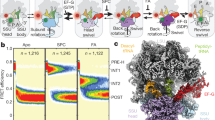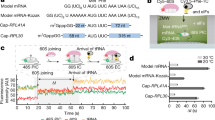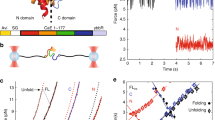Abstract
Characterizing the structural dynamics of the translating ribosome remains a major goal in the study of protein synthesis. Deacylation of peptidyl-tRNA during translation elongation triggers fluctuations of the pretranslocation ribosomal complex between two global conformational states. Elongation factor G–mediated control of the resulting dynamic conformational equilibrium helps to coordinate ribosome and tRNA movements during elongation and is thus a crucial mechanistic feature of translation. Beyond elongation, deacylation of peptidyl-tRNA also occurs during translation termination, and this deacylated tRNA persists during ribosome recycling. Here we report that specific regulation of the analogous conformational equilibrium by translation release and ribosome recycling factors has a critical role in the termination and recycling mechanisms. Our results support the view that specific regulation of the global state of the ribosome is a fundamental characteristic of all translation factors and a unifying theme throughout protein synthesis.
This is a preview of subscription content, access via your institution
Access options
Subscribe to this journal
Receive 12 print issues and online access
$189.00 per year
only $15.75 per issue
Buy this article
- Purchase on Springer Link
- Instant access to full article PDF
Prices may be subject to local taxes which are calculated during checkout







Similar content being viewed by others
References
Frank, J. & Agrawal, R.K. A ratchet-like inter-subunit reorganization of the ribosome during translocation. Nature 406, 318–322 (2000).
Valle, M. et al. Locking and unlocking of ribosomal motions. Cell 114, 123–134 (2003).
Gao, N. et al. Mechanism for the disassembly of the posttermination complex inferred from cryo-EM studies. Mol. Cell 18, 663–674 (2005).
Gao, H. et al. RF3 induces ribosomal conformational changes responsible for dissociation of class I release factors. Cell 129, 929–941 (2007).
Connell, S.R. et al. Structural basis for interaction of the ribosome with the switch regions of GTP-bound elongation factors. Mol. Cell 25, 751–764 (2007).
Agirrezabala, X. et al. Visualization of the hybrid state of tRNA binding promoted by spontaneous ratcheting of the ribosome. Mol. Cell 32, 190–197 (2008).
Julián, P. et al. Structure of ratcheted ribosomes with tRNAs in hybrid states. Proc. Natl. Acad. Sci. USA 105, 16924–16927 (2008).
Fei, J., Kosuri, P., MacDougall, D.D. & Gonzalez, R.L. Jr. Coupling of ribosomal L1 stalk and tRNA dynamics during translation elongation. Mol. Cell 30, 348–359 (2008).
Ermolenko, D.N. et al. Observation of intersubunit movement of the ribosome in solution using FRET. J. Mol. Biol. 370, 530–540 (2007).
Cornish, P.V., Ermolenko, D.N., Noller, H.F. & Ha, T. Spontaneous intersubunit rotation in single ribosomes. Mol. Cell 30, 578–588 (2008).
Cornish, P.V. et al. Following movement of the L1 stalk between three functional states in single ribosomes. Proc. Natl. Acad. Sci. USA 106, 2571–2576 (2009).
Traut, R.R. & Monro, R.E. The puromycin reaction and its relation to protein synthesis. J. Mol. Biol. 10, 63–72 (1964).
Freistroffer, D.V., Pavlov, M.Y., MacDougall, J., Buckingham, R.H. & Ehrenberg, M. Release factor RF3 in E. coli accelerates the dissociation of release factors RF1 and RF2 from the ribosome in a GTP-dependent manner. EMBO J. 16, 4126–4133 (1997).
Zavialov, A.V., Buckingham, R.H. & Ehrenberg, M. A posttermination ribosomal complex is the guanine nucleotide exchange factor for peptide release factor RF3. Cell 107, 115–124 (2001).
Hirokawa, G. et al. The role of ribosome recycling factor in dissociation of 70S ribosomes into subunits. RNA 11, 1317–1328 (2005).
Zavialov, A.V., Hauryliuk, V.V. & Ehrenberg, M. Splitting of the posttermination ribosome into subunits by the concerted action of RRF and EF-G. Mol. Cell 18, 675–686 (2005).
Peske, F., Rodnina, M.V. & Wintermeyer, W. Sequence of steps in ribosome recycling as defined by kinetic analysis. Mol. Cell 18, 403–412 (2005).
Rawat, U. et al. Interactions of the release factor RF1 with the ribosome as revealed by cryo-EM. J. Mol. Biol. 357, 1144–1153 (2006).
Klaholz, B.P., Myasnikov, A.G. & Van Heel, M. Visualization of release factor 3 on the ribosome during termination of protein synthesis. Nature 427, 862–865 (2004).
Barat, C. et al. Progression of the ribosome recycling factor through the ribosome dissociates the two ribosomal subunits. Mol. Cell 27, 250–261 (2007).
Wilson, K.S., Ito, K., Noller, H.F. & Nakamura, Y. Functional sites of interaction between release factor RF1 and the ribosome. Nat. Struct. Biol. 7, 866–870 (2000).
Bastiaens, P.I. & Jovin, T.M. Microspectroscopic imaging tracks the intracellular processing of a signal transduction protein: fluorescent-labeled protein kinase C beta I. Proc. Natl. Acad. Sci. USA 93, 8407–8412 (1996).
Hohng, S., Joo, C. & Ha, T. Single-molecule three-color FRET. Biophys. J. 87, 1328–1337 (2004).
Laurberg, M. et al. Structural basis for translation termination on the 70S ribosome. Nature 454, 852–857 (2008).
Zavialov, A.V., Mora, L., Buckingham, R.H. & Ehrenberg, M. Release of peptide promoted by the GGQ motif of class 1 release factors regulates the GTPase activity of RF3. Mol. Cell 10, 789–798 (2002).
Blanchard, S.C., Kim, H.D., Gonzalez, R.L. Jr, Puglisi, J.D. & Chu, S. tRNA dynamics on the ribosome during translation. Proc. Natl. Acad. Sci. USA 101, 12893–12898 (2004).
Kim, H.D., Puglisi, J.D. & Chu, S. Fluctuations of transfer RNAs between classical and hybrid states. Biophys. J. 93, 3575–3582 (2007).
Munro, J.B., Altman, R.B., O'Connor, N. & Blanchard, S.C. Identification of two distinct hybrid state intermediates on the ribosome. Mol. Cell 25, 505–517 (2007).
Bartley, L.E., Zhuang, X., Das, R., Chu, S. & Herschlag, D. Exploration of the transition state for tertiary structure formation between an RNA helix and a large structured RNA. J. Mol. Biol. 328, 1011–1026 (2003).
Petry, S. et al. Crystal structures of the ribosome in complex with release factors RF1 and RF2 bound to a cognate stop codon. Cell 123, 1255–1266 (2005).
Mora, L., Zavialov, A., Ehrenberg, M. & Buckingham, R.H. Stop codon recognition and interactions with peptide release factor RF3 of truncated and chimeric RF1 and RF2 from Escherichia coli. Mol. Microbiol. 50, 1467–1476 (2003).
Karimi, R., Pavlov, M.Y., Buckingham, R.H. & Ehrenberg, M. Novel roles for classical factors at the interface between translation termination and initiation. Mol. Cell 3, 601–609 (1999).
Sarkar, S.K. et al. Engineered Holliday junctions as single-molecule reporters for protein-DNA interactions with application to a MerR-family regulator. J. Am. Chem. Soc. 129, 12461–12467 (2007).
Agrawal, R.K. et al. Visualization of ribosome-recycling factor on the Escherichia coli 70S ribosome: functional implications. Proc. Natl. Acad. Sci. USA 101, 8900–8905 (2004).
Weixlbaumer, A. et al. Crystal structure of the ribosome recycling factor bound to the ribosome. Nat. Struct. Mol. Biol. 14, 733–737 (2007).
Borovinskaya, M.A. et al. Structural basis for aminoglycoside inhibition of bacterial ribosome recycling. Nat. Struct. Mol. Biol. 14, 727–732 (2007).
Lancaster, L., Kiel, M.C., Kaji, A. & Noller, H.F. Orientation of ribosome recycling factor in the ribosome from directed hydroxyl radical probing. Cell 111, 129–140 (2002).
Hirokawa, G. et al. Binding of ribosome recycling factor to ribosomes, comparison with tRNA. J. Biol. Chem. 277, 35847–35852 (2002).
Kiel, M.C., Raj, V.S., Kaji, H. & Kaji, A. Release of ribosome-bound ribosome recycling factor by elongation factor G. J. Biol. Chem. 278, 48041–48050 (2003).
Seo, H.S. et al. Kinetics and thermodynamics of RRF, EF-G, and thiostrepton interaction on the Escherichia coli ribosome. Biochemistry 43, 12728–12740 (2004).
Pavlov, M.Y., Antoun, A., Lovmar, M. & Ehrenberg, M. Complementary roles of initiation factor 1 and ribosome recycling factor in 70S ribosome splitting. EMBO J. 27, 1706–1717 (2008).
Janosi, L. et al. Evidence for in vivo ribosome recycling, the fourth step in protein biosynthesis. EMBO J. 17, 1141–1151 (1998).
Hirokawa, G., Inokuchi, H., Kaji, H., Igarashi, K. & Kaji, A. In vivo effect of inactivation of ribosome recycling factor—fate of ribosomes after unscheduled translation downstream of open reading frame. Mol. Microbiol. 54, 1011–1021 (2004).
Zavialov, A.V. & Ehrenberg, M. Peptidyl-tRNA regulates the GTPase activity of translation factors. Cell 114, 113–122 (2003).
Spahn, C.M. et al. Domain movements of elongation factor eEF2 and the eukaryotic 80S ribosome facilitate tRNA translocation. EMBO J. 23, 1008–1019 (2004).
Taylor, D.J. et al. Structures of modified eEF2 80S ribosome complexes reveal the role of GTP hydrolysis in translocation. EMBO J. 26, 2421–2431 (2007).
Dinçbas-Renqvist, V. et al. A post-translational modification in the GGQ motif of RF2 from Escherichia coli stimulates termination of translation. EMBO J. 19, 6900–6907 (2000).
Heurgué-Hamard, V., Champ, S., Engstrom, A., Ehrenberg, M. & Buckingham, R.H. The hemK gene in Escherichia coli encodes the N5-glutamine methyltransferase that modifies peptide release factors. EMBO J. 21, 769–778 (2002).
Gonzalez, R.L., Jr, Chu, S. & Puglisi, J.D. Thiostrepton inhibition of tRNA delivery to the ribosome. RNA 13, 2091–2097 (2007).
McKinney, S.A., Joo, C. & Ha, T. Analysis of single-molecule FRET trajectories using hidden Markov modeling. Biophys. J. 91, 1941–1951 (2006).
Acknowledgements
This work was supported in part by start-up funds to R.L.G. from Columbia University, as well as grants to R.L.G. from the Burroughs Wellcome Fund (CABS 1004856), the US National Science Foundation (MCB 0644262) and the American Cancer Society (RSG GMC-117152). S.H.S. was supported, in part, by the Columbia University Langmuir Scholars Program, and N.P. was supported, in part, by the Columbia University Summer Undergraduate Research Fellowship (SURF) Program. We are indebted to S. Das for managing the Gonzalez laboratory. We thank J. Frank, E. Greene, N. Gao and the members of the Gonzalez laboratory for valuable discussions and for carefully reading the manuscript and providing comments.
Author information
Authors and Affiliations
Contributions
S.H.S. and R.L.G. designed the research; S.H.S. conducted the research, except for the release factor activity assays, which were conducted by S.H.S, N.P. and K.A.M., and purification of RRF, which was conducted by N.P.; J.F. provided L1(Cy5) ribosomes and offered critical discussions related to data analysis and interpretation; S.H.S. and R.L.G. wrote the manuscript; all authors approved the final manuscript.
Corresponding author
Supplementary information
Supplementary Text and Figures
Supplementary Figures 1–9 and Supplementary Methods (PDF 2041 kb)
Rights and permissions
About this article
Cite this article
Sternberg, S., Fei, J., Prywes, N. et al. Translation factors direct intrinsic ribosome dynamics during translation termination and ribosome recycling. Nat Struct Mol Biol 16, 861–868 (2009). https://doi.org/10.1038/nsmb.1622
Received:
Accepted:
Published:
Issue Date:
DOI: https://doi.org/10.1038/nsmb.1622
This article is cited by
-
Quality control of protein synthesis in the early elongation stage
Nature Communications (2023)
-
Multiplexed genomic encoding of non-canonical amino acids for labeling large complexes
Nature Chemical Biology (2020)
-
ArfB can displace mRNA to rescue stalled ribosomes
Nature Communications (2020)
-
Structural basis for ribosome recycling by RRF and tRNA
Nature Structural & Molecular Biology (2020)
-
Visualization of translation termination intermediates trapped by the Apidaecin 137 peptide during RF3-mediated recycling of RF1
Nature Communications (2018)



